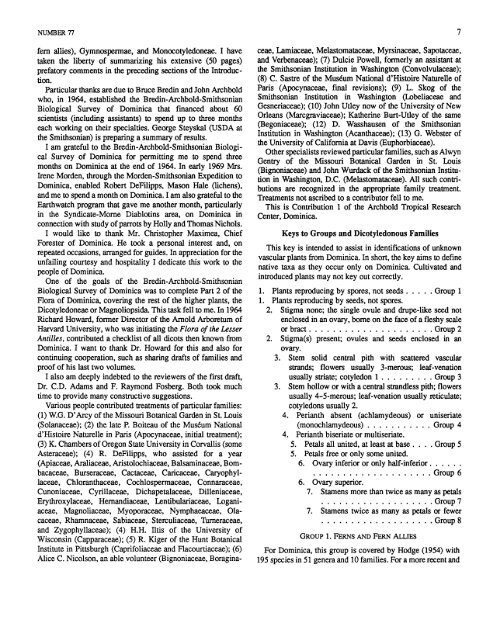Flora of Dominica, Part 2 - Smithsonian Institution Libraries
Flora of Dominica, Part 2 - Smithsonian Institution Libraries
Flora of Dominica, Part 2 - Smithsonian Institution Libraries
You also want an ePaper? Increase the reach of your titles
YUMPU automatically turns print PDFs into web optimized ePapers that Google loves.
NUMBER^<br />
fern allies), Gymnosprmae, and Monocotyledoneae. I have<br />
taken the liberty <strong>of</strong> summarizing his extensive (50 pages)<br />
prefatory comments in the preceding sections <strong>of</strong> the Introduction.<br />
<strong>Part</strong>icular thanks are due to Bruce Bredin and John Archbold<br />
who, in 1964, established the Bredin-Archbold-<strong>Smithsonian</strong><br />
Biological Survey <strong>of</strong> <strong>Dominica</strong> that financed about 60<br />
scientists (including assistants) to spend up to three months<br />
each working on their specialties. George Steyskal (USDA at<br />
the <strong>Smithsonian</strong>) is preparing a summary <strong>of</strong> results.<br />
I am grateful to the Bredin-Archbold-<strong>Smithsonian</strong> Biological<br />
Survey <strong>of</strong> <strong>Dominica</strong> for permitting me to spend three<br />
months on <strong>Dominica</strong> at the end <strong>of</strong> 1964. In early 1969 Mrs.<br />
Irene Morden, through the Morden-<strong>Smithsonian</strong> Expedition to<br />
<strong>Dominica</strong>, enabled Robert DeFilipps, Mason Hale (lichens),<br />
and me to spend a month on <strong>Dominica</strong>. I am also grateful to the<br />
Earthwatch program that gave me another month, particularly<br />
in the Syndicate-Mome Diablotins area, on <strong>Dominica</strong> in<br />
connection with study <strong>of</strong> parrots by Holly and Thomas Nichols.<br />
I would like to thank Mr. Christopher Maximea, Chief<br />
Forester <strong>of</strong> <strong>Dominica</strong>. He took a personal interest and, on<br />
repeated occasions, arranged for guides. In appreciation for the<br />
unfailing courtesy and hospitality I dedicate this work to the<br />
people <strong>of</strong> <strong>Dominica</strong>.<br />
One <strong>of</strong> the goals <strong>of</strong> the Bredin-Archbold-<strong>Smithsonian</strong><br />
Biological Survey <strong>of</strong> <strong>Dominica</strong> was to complete <strong>Part</strong> 2 <strong>of</strong> the<br />
<strong>Flora</strong> <strong>of</strong> <strong>Dominica</strong>, covering the rest <strong>of</strong> the higher plants, the<br />
Dicotyledoneae or Magnoliopsida. This task fell to me. In 1964<br />
Richard Howard, former Director <strong>of</strong> the Arnold Arboretum <strong>of</strong><br />
Harvard University, who was initiating the <strong>Flora</strong> <strong>of</strong> the Lesser<br />
Antilles, contributed a checklist <strong>of</strong> all dicots then known from<br />
<strong>Dominica</strong>. I want to thank Dr. Howard for this and also for<br />
continuing cooperation, such as sharing drafts <strong>of</strong> families and<br />
pro<strong>of</strong> <strong>of</strong> his last two volumes.<br />
I also am deeply indebted to the reviewers <strong>of</strong> the first draft,<br />
Dr. C.D. Adams and F. Raymond Fosberg. Both took much<br />
time to provide many constructive suggestions.<br />
Various people contributed treatments <strong>of</strong> particular families:<br />
(1) W.G. D’Arcy <strong>of</strong> the Missouri Botanical Garden in St. Louis<br />
(Solanaceae); (2) the late P. Boiteau <strong>of</strong> the Museum National<br />
d’Histoire Naturelle in Paris (Apocynaceae, initial treatment);<br />
(3) K. Chambers <strong>of</strong> Oregon State University in Corvallis (some<br />
Asteraceae); (4) R. DeFilipps, who assisted for a year<br />
(Apiaceae, Araliaceae, Aristolochiaceae, Balsaminaceae, Bombacaceae,<br />
Burseraceae, Cactaceae, Caricaceae, Caryophyllaceae,<br />
Chloranthaceae, Cochlospermaceae, Connaraceae,<br />
Cunoniaceae, Cyrillaceae, Dichapetalaceae, Dilleniaceae,<br />
Erythroxylaceae, Hemandiaceae, Lentibulariaceae, Loganiaceae,<br />
Magnoliaceae, Myoporaceae, Nymphaeaceae, Olacaceae,<br />
Rhamnaceae, Sabiaceae, Sterculiaceae, lkmeraceae,<br />
and Zygophyllaceae); (4) H.H. 11th <strong>of</strong> the University <strong>of</strong><br />
Wisconsin (Capparaceae); (5) R. Kiger <strong>of</strong> the Hunt Botanical<br />
Institute in Pittsburgh (Caprifoliaceae and Flacourtiaceae); (6)<br />
Alice C. Nicolson, an able volunteer (Bignoniaceae, Boragina-<br />
ceae, Lamiaceae, Melastomataceae, Myrsinaceae, Sapotaceae,<br />
and Verbenaceae); (7) Dulcie Powell, formerly an assistant at<br />
the <strong>Smithsonian</strong> <strong>Institution</strong> in Washington (Convolvulaceae);<br />
(8) C. Sastre <strong>of</strong> the Museum National d’Histoire Naturelle <strong>of</strong><br />
Paris (Apocynaceae, final revisions); (9) L. Skog <strong>of</strong> the<br />
<strong>Smithsonian</strong> <strong>Institution</strong> in Washington (Lobeliaceae and<br />
Gesneriaceae); (10) John Utley now <strong>of</strong> the University <strong>of</strong> New<br />
Orleans (Marcgraviaceae); Katherine Burt-Utley <strong>of</strong> the Same<br />
(Begoniaceae); (12) D. Wasshausen <strong>of</strong> the <strong>Smithsonian</strong><br />
<strong>Institution</strong> in Washington (Acanthaceae); (1 3) G. Webster <strong>of</strong><br />
the University <strong>of</strong> California at Davis (Euphorbiaceae).<br />
Other specialists reviewed particular families, such as Alwyn<br />
Gentry <strong>of</strong> the Missouri Botanical Garden in St. Louis<br />
(Bignoniaceae) and John Wurdack <strong>of</strong> the <strong>Smithsonian</strong> <strong>Institution</strong><br />
in Washington, D.C. (Melastomataceae). All such conhibutions<br />
are recognized in the appropriate family treatment.<br />
Treatments not ascribed to a contributor fell to me.<br />
This is Contribution 1 <strong>of</strong> the Archbold Tropical Research<br />
Center, <strong>Dominica</strong>.<br />
Keys to Groups and Dicotyledonous Families<br />
This key is intended to assist in identifications <strong>of</strong> unknown<br />
vascular plants from <strong>Dominica</strong>. In short, the key aims to define<br />
native taxa as they occur only on <strong>Dominica</strong>. Cultivated and<br />
introduced plants may not key out correctly.<br />
1. Plants reproducing by spores, not seeds ..... Group 1<br />
1. Plants reproducing by seeds, not spores.<br />
2. Stigma none; the single ovule and drupe-like seed not<br />
enclosed in an ovary, borne on the face <strong>of</strong> a fleshy scale<br />
or bract ..................... Group 2<br />
2. Stigma(s) present; ovules and seeds enclosed in an<br />
ovary.<br />
3. Stem solid central pith with scattered vascular<br />
strands; flowers usually 3-merous; leaf-venation<br />
usually striate; cotyledon 1 ......... Group 3<br />
3. Stem hollow or with a central strandless pith; flowers<br />
usually 4-5-merous; leaf-venation usually reticulate;<br />
cotyledons usually 2.<br />
4. Perianth absent (achlamydeous) or uniseriate<br />
(monochlamydeous) ........... Group 4<br />
4. Perianth biseriate or multiseriate.<br />
5. Petals all united, at least at base .... Group 5<br />
5. Petals free or only some united.<br />
6. Ovary inferior or only half-inferior ......<br />
.................... Group 6<br />
6. Ovary superior.<br />
7. Stamens more than twice as many as petals<br />
................... Group 7<br />
7. Stamens twice as many as petals or fewer<br />
................... Group 8<br />
GROUP 1. FERNS AND FERN ALLIW<br />
For <strong>Dominica</strong>, this group is covered by Hodge (1954) with<br />
195 species in 51 genera and 10 families. For a more recent and
















